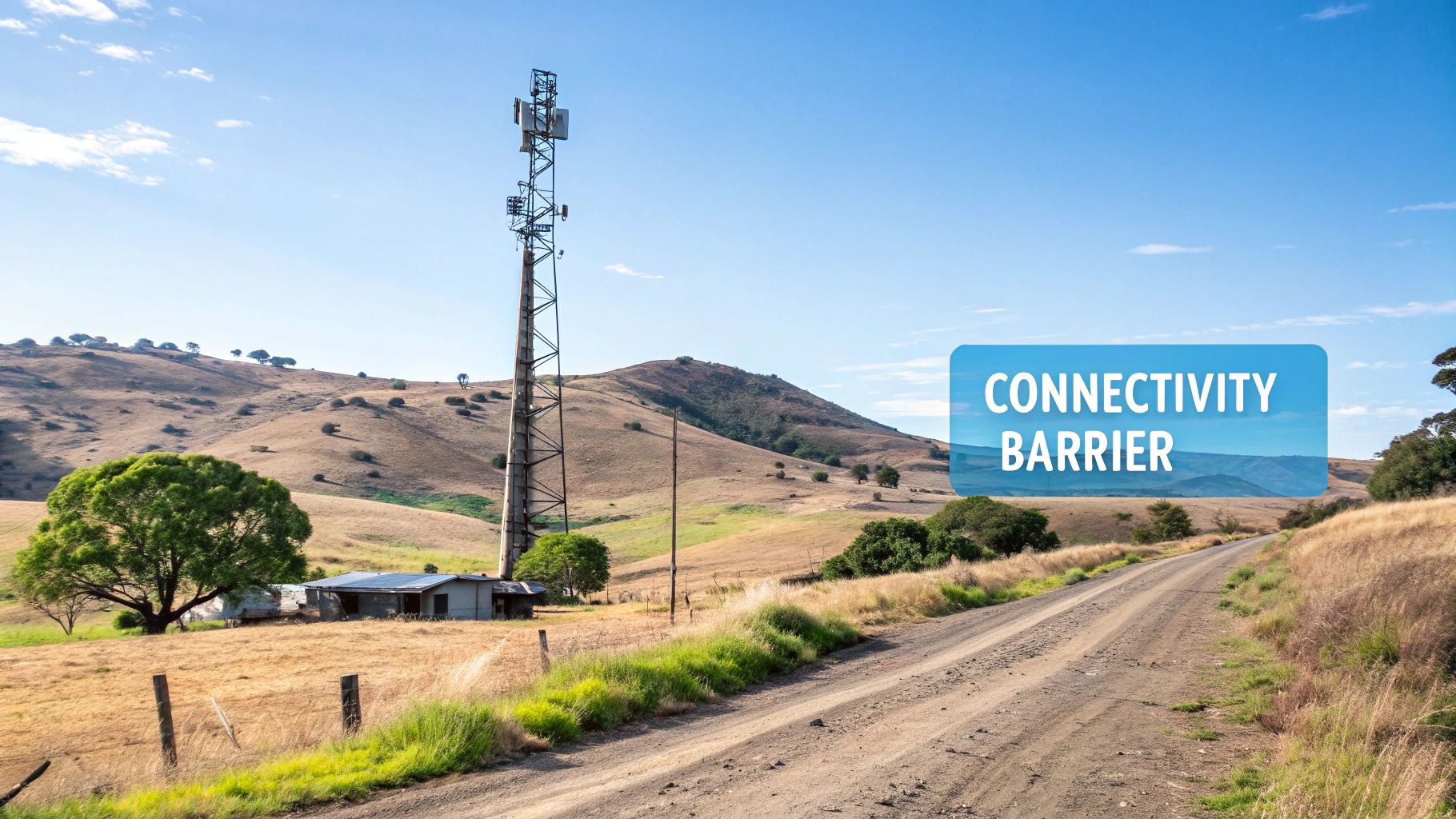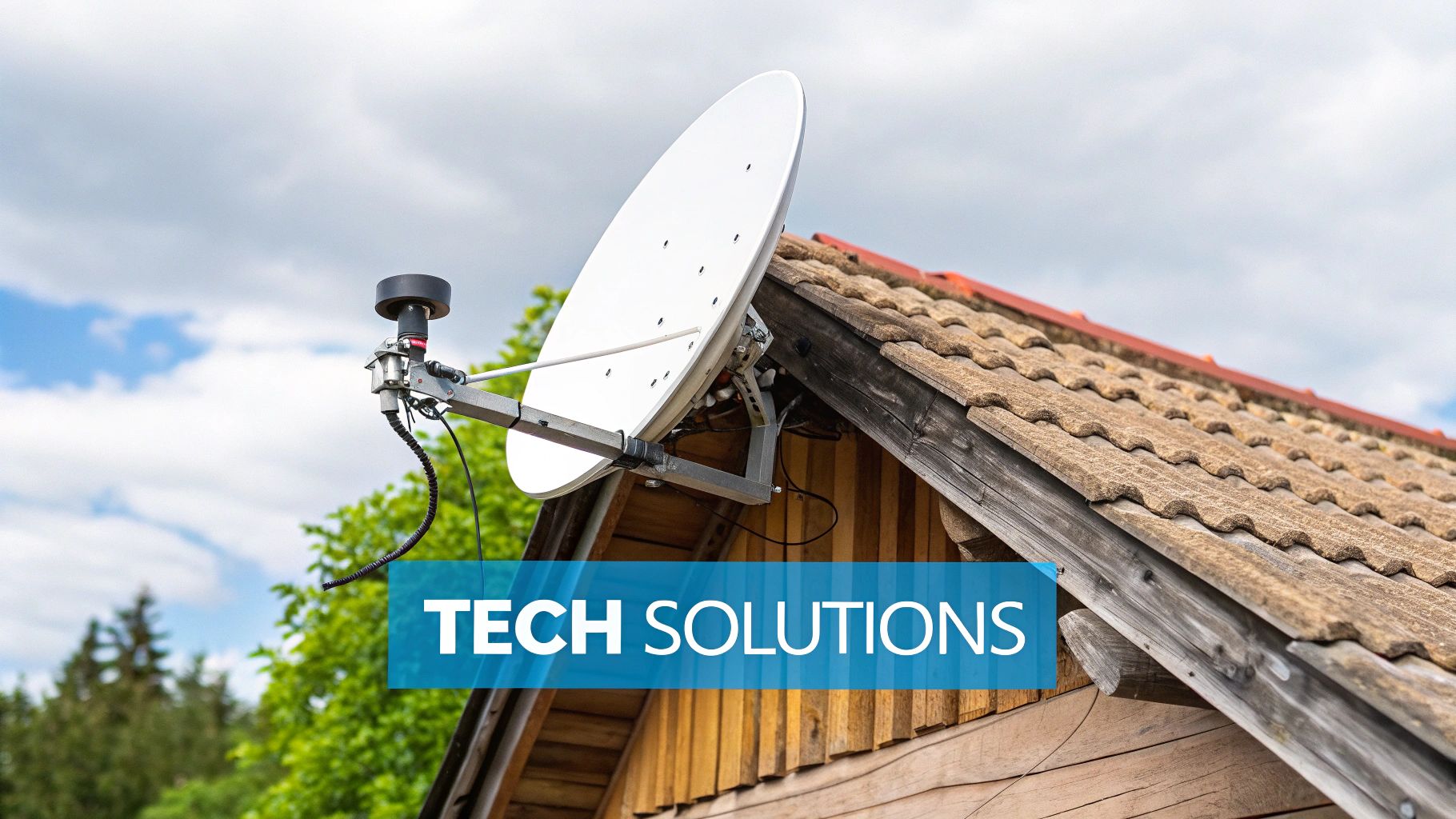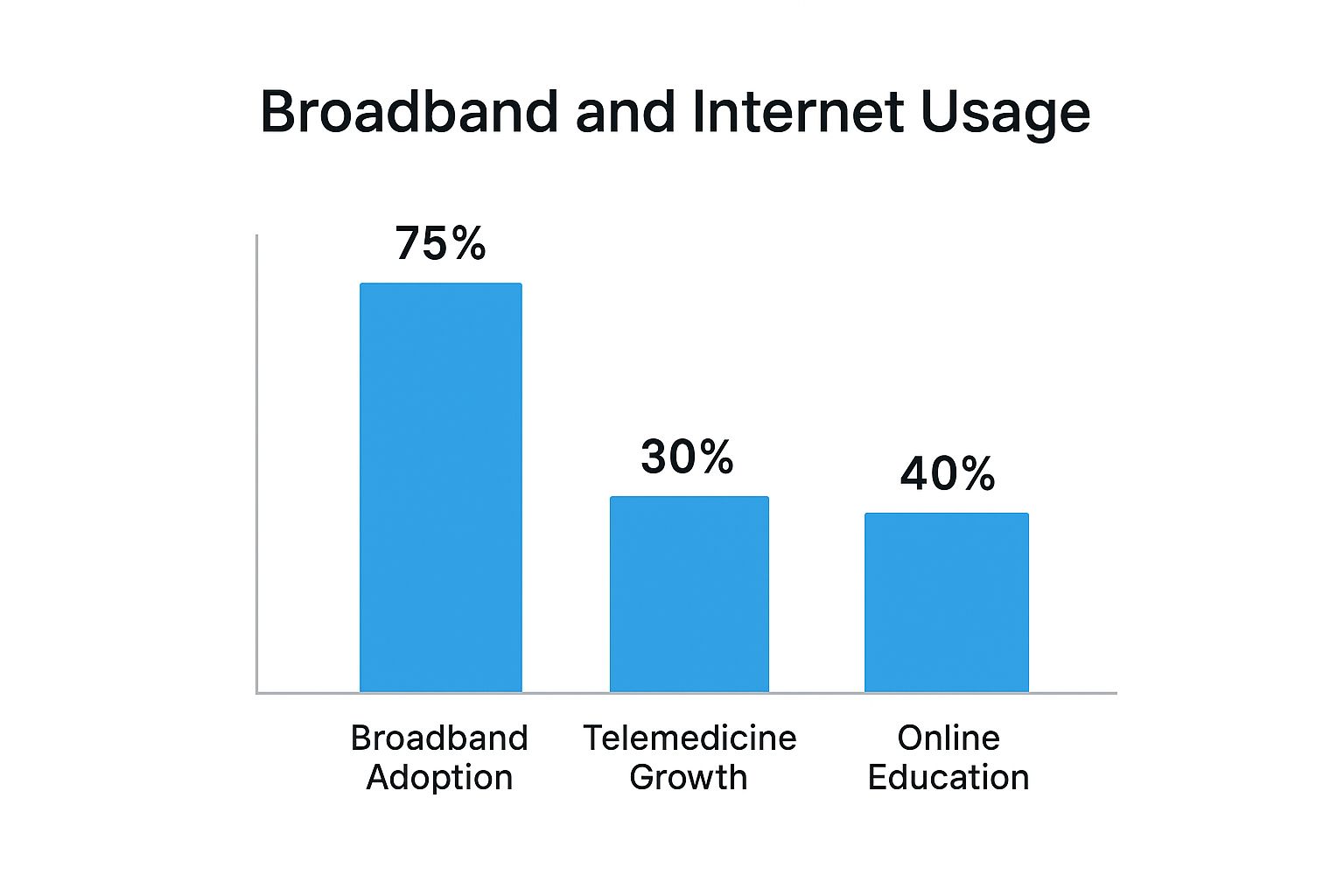

· Por James
Finding Internet Access for Rural Areas
If you live outside the city, you know the struggle. Dealing with slow, unreliable, or flat-out non-existent internet is a daily frustration for millions of us. But here's the good news: getting dependable internet access for rural areas is no longer a pipe dream, thanks to some big leaps in technology like satellite, fixed wireless, and 5G home internet.
Figuring out the best option really boils down to your specific address, what you need the internet for, and which providers can actually reach your home.
Bridging the Digital Divide in Rural America
For way too long, a solid internet connection felt like a luxury only people in cities and suburbs could count on. Not anymore. Today, it’s just as vital as electricity or running water. It's the key to remote work, online classes for your kids, modern healthcare access, and even just staying in touch with family.
When that access is missing, a "digital divide" opens up, putting rural communities on the back foot. This isn't just a problem here at home; it's a global issue. The connectivity gap looks different all over the world. In Europe, for example, about 86% of rural homes have internet, which is pretty close to their urban areas. Contrast that with Africa, where rural internet access is only around 23%. These numbers, available in more detail on Statista, paint a clear picture: while some places are closing the gap, many rural communities are still fighting to get online.
New Ways to Get Connected
Thankfully, the era of painfully slow dial-up and flaky DSL is finally starting to fade. A new wave of technology is built specifically to bring good internet to homes like ours.
Think of it like a delivery service. Fiber optic cables are the superhighway system, but that highway probably doesn't have an exit ramp at your driveway just yet. That’s okay, because other methods can still get the package—your data—right to your door:
- Satellite Internet: This is like an all-terrain vehicle that can get anywhere. A signal is beamed down from space directly to a small dish on your roof.
- Fixed Wireless: Picture this as a high-tech delivery drone. A signal travels from a nearby tower straight to a receiver on your house, creating a fast, direct link.
- 5G Home Internet: This uses the same powerful cell networks our smartphones rely on to bring high-speed internet into your home through a dedicated router.
The real challenge now isn't a total lack of options. It's figuring out which technology gives you the right mix of speed, reliability, and cost for your family. Each one has its own pros and cons, which we'll get into.
The goal is to move past the frustration and find a real, practical solution that actually works for you. Once you understand how these technologies operate, you can make a smart choice and finally close your own personal digital divide. For a deeper dive, check out our guide on how rural high-speed internet is changing communities.
How Satellite Internet Connects the Most Remote Homes

When the pavement ends and cell service is a distant memory, satellite internet often steps in as the last line of defense against being totally disconnected. For countless people looking for internet access for rural areas, this technology is the only game in town. It’s a lifeline capable of reaching homes tucked away in the mountains, deep in the woods, or miles down a gravel road where no cable will ever go.
It all works like a long-distance conversation happening at incredible speeds. The journey starts at a small dish on your house, which beams a signal up to a satellite orbiting thousands of miles above the planet. That satellite then shoots the signal back down to a ground station (often called a network operations center) that’s plugged into the global internet. To get data back to you—say, to load this webpage—the entire process happens in reverse.
The biggest advantage here is simple: reach. If your home has a clear view of the sky, you can probably get satellite internet.
The Tradeoffs of Traditional Satellite
For all its amazing reach, traditional satellite internet has some well-known drawbacks. The sheer distance the signal has to travel is the main culprit. For the older, geostationary satellites, that's a round trip of over 44,000 miles. This massive journey creates a noticeable delay we call latency.
You might not even notice this lag when you're just browsing websites or firing off an email, but it becomes a real deal-breaker for anything happening in real time.
- Video Calls: High latency is what causes that awkward "talking over each other" dance on Zoom or FaceTime calls. The delay makes natural conversation almost impossible.
- Online Gaming: Forget about it. Fast-paced games become completely unplayable because your character can't react quickly enough to what’s happening on screen.
- VPN Connections: Many remote workers discover that high latency makes their company's Virtual Private Network (VPN) unstable, leading to constant and frustrating disconnects.
This physical limitation is the fundamental reason traditional satellite service has struggled with real-time applications. The data simply has too far to travel, making it a poor fit for anything that requires an instant response.
On top of the lag, users often run into other headaches. Data caps are a common restriction, limiting how much you can download or stream before your speeds get throttled down to a crawl. Nasty weather like heavy rain or a blizzard can also get in the way of the signal, causing outages right when you need a connection the most.
The LEO Satellite Revolution
Just when it seemed like satellite internet was permanently stuck with these issues, a completely new way of doing things came along and flipped the script. Low Earth Orbit (LEO) satellite systems, with Starlink being the most famous example, are a massive leap forward.
Instead of just a few huge satellites parked way out in space, LEO systems use thousands of smaller satellites flying much, much closer to home—only about 340 miles up. Think of it like shouting to a friend across a football field instead of trying to get their attention from a mile away. The shorter distance drastically cuts down the signal's travel time.
This close proximity has a direct and massive impact on performance, fixing many of the biggest pain points that came with older satellite tech.
How LEO Technology Improves the Experience
| Feature | Traditional Satellite | LEO Satellite (e.g., Starlink) |
|---|---|---|
| Latency | High (600+ ms) | Low (20-40 ms) |
| Typical Speeds | Slower (25-100 Mbps) | Faster (100-200+ Mbps) |
| Data Caps | Often strict | Typically unlimited |
| Best For | Basic browsing, email | Streaming, gaming, video calls, remote work |
This huge drop in latency makes LEO satellite feel incredibly snappy and responsive, almost like you’re on a fiber or cable connection. Video calls are crystal clear, online gaming is actually competitive, and you can stream 4K movies without that dreaded buffering wheel. For many rural families and workers, this isn’t just a small step up; it’s a whole new world, finally bringing true high-performance internet access for rural areas into the realm of possibility.
Understanding Fixed Wireless Internet Technology

While satellite can reach the most far-flung locations, Fixed Wireless Access (FWA) has stepped up as a fantastic middle-ground. It often delivers fiber-like performance without the massive undertaking of running physical cables to your door. For many folks in the countryside, it’s a total game-changer, offering reliable internet access for rural areas that are close enough to a service tower.
So how does it work? Imagine a powerful, invisible beam of internet shot straight from a nearby tower to a small receiver on your house. That's fixed wireless in a nutshell. It’s not like the mobile data on your phone, which jumps between towers as you move. This is a stationary, dedicated link between two specific points: the provider’s tower and your home.
This direct connection is the secret sauce. It completely sidesteps the need for expensive and disruptive trenching to lay fiber optic or coaxial cables. This makes it a much quicker and more affordable way to get entire rural communities online.
The Importance of Line of Sight
The make-or-break factor for fixed wireless is something called line of sight. For the system to work its magic, the receiver on your home needs a clear, unobstructed path to the provider's tower. No exceptions.
Think of it like trying to see a lighthouse from your window. If a big hill, a dense patch of trees, or even your neighbor's new barn gets in the way, you won’t see the light. It's the same idea here—those physical obstacles can easily block the radio waves carrying your internet signal. This is the main hurdle for FWA and the very first thing a provider will check out.
Key Takeaway: A clear line of sight is non-negotiable for a stable fixed wireless connection. Providers use specialized mapping tools and sometimes even on-site surveys to confirm that your home has an unblocked path to their tower before scheduling an installation.
Because of this strict requirement, availability can be incredibly specific. Your neighbor right across the road might be good to go, while your home, tucked just behind a small ridge, is out of luck.
Strengths of Fixed Wireless Internet
When you do have that solid line-of-sight connection, fixed wireless really shines. It brings a unique blend of speed and responsiveness to the table that makes it a top pick for many rural homes.
Here's where it stands out:
- Low Latency: The signal only has to travel a few miles to the nearest tower, so the delay (or latency) is incredibly low. This is a huge plus for video calls, remote work that uses a VPN, and especially online gaming.
- High Speeds: FWA can deliver download speeds that compete with, and sometimes even beat, cable internet. We're talking anywhere from 50 Mbps to over 300 Mbps. That’s more than enough muscle for streaming 4K movies, supporting a house full of devices, and running a smart home.
- Reliability: Once it's installed and aimed correctly, the connection is rock-solid. It's not as prone to the big outages that can sometimes knock out cable networks, and it's far less affected by weather than satellite internet.
This combination of perks makes FWA a powerful solution that meets the demands of modern life, whether that's online school, streaming your favorite shows, or running a business from your kitchen table.
Recognizing its potential, there are major efforts underway to expand this kind of infrastructure. In the United States, federal programs are injecting serious funding to build out high-speed networks in underserved regions. The USDA's ReConnect Program, for example, has funneled billions since 2018 to help providers build this critical broadband infrastructure. It's a smart investment, too, with estimates suggesting it could drive an $18 billion annual economic boost for rural America. You can learn more about how these government investments are closing the digital divide on usda.gov.
Using Cellular Networks for Home Internet

Beyond satellite dishes and fixed wireless towers, another powerful option for internet access for rural areas uses the same technology that’s probably in your pocket right now: the cellular network. Both 4G LTE and the newer, lightning-fast 5G are now offered as dedicated home internet services, bringing a surprisingly simple and effective solution to many rural households.
This isn't just about tethering to your phone or relying on a tiny mobile hotspot. Instead, providers send you a dedicated in-home router that's built specifically to pull in the strongest possible cell signal and then broadcast it as Wi-Fi throughout your home. Think of it as a supercharged version of your phone's internet, designed to handle the demands of a whole household.
Perhaps the biggest draw is the ridiculously easy setup. In most cases, there’s no technician, no appointments, and no drilling holes in your walls. They just mail you a router, you plug it in near a window, and you’re online in minutes.
The Power and Pitfalls of Signal Strength
The performance of cellular home internet really comes down to one thing: your home's relationship with the nearest cell tower. Your speed and reliability are directly tied to the strength of that signal when it hits your router. If you've got a strong, clear signal, you can get some seriously fast speeds—especially with 5G—that are more than enough for streaming, gaming, and working from home.
But if that signal is weak or spotty, your internet experience is going to suffer. That's the main catch with this technology.
Several things can get in the way of a good signal:
- Distance to the Tower: This is the most common challenge in remote areas. The farther away you are, the weaker the signal gets.
- Physical Obstructions: Things like hills, thick forests, and even certain building materials can block or degrade cellular signals.
- Network Congestion: You're sharing the airwaves with every other mobile user in the area. During peak times, like evenings when everyone is home streaming movies, you might see your speeds dip as the local tower gets overloaded.
A great way to get a sneak peek at potential performance is to just use your smartphone. Walk around your house and check the signal bars or, even better, run a speed test. While the dedicated home router is more powerful, your phone's signal strength can give you a pretty solid clue about what to expect.
Costs and Data Considerations
Cellular home internet is often priced very competitively. Most providers offer plans somewhere between $50 and $70 per month, and you can sometimes snag a discount if you’re already a mobile customer with them. Many of these plans now come with truly unlimited data, which is a huge step up from the restrictive data caps you often see with satellite internet.
For those digging into cellular options, it can be helpful to understand the wider world of mobile connectivity, including the best SIM card options for mobile connectivity. Although a home internet router uses its own internal system, the core technology is one and the same.
The main cost you'll run into is the router itself, but most providers just include the equipment rental in the monthly fee, keeping upfront costs extremely low. This simple pricing and plug-and-play setup is making cellular an increasingly popular choice, bridging the gap for many who need reliable internet access for rural areas but are just out of reach of other options. As long as a cell tower is within shouting distance, it can bring modern speeds right to your doorstep.
Comparing Your Rural Internet Options Head-to-Head
Okay, now that we've walked through the different technologies, it's time to get practical. Choosing the right internet for your rural spot isn't about picking the fanciest tech on the market. It's about figuring out what actually works for your specific location, your lifestyle, and your wallet.
The whole game is matching a service's strengths to what you do online every day.
Start by asking yourself what you really need the internet for. Is your top priority binge-watching Netflix without that dreaded buffering wheel? Or do you need the lightning-fast, low-latency connection that makes video calls and online gaming feel seamless? Answering those questions honestly will instantly help you cut through the noise and focus on what makes sense for your home.
Weighing Your Priorities
Your final choice will almost always come down to a balancing act between availability, performance, and cost. For instance, satellite can beam a signal to just about anywhere, but fixed wireless often delivers lower latency if you're lucky enough to be in range of a tower. Cellular is incredibly convenient, but your experience lives and dies by your signal strength.
Think about these key factors:
- Primary Use: Are you working from home and need a stable VPN connection, or are you mostly just browsing the web and checking emails?
- Performance Needs: Is a super-responsive connection for gaming a non-negotiable, or is reliable speed for streaming your main concern?
- Budget: What are you comfortable spending on equipment upfront versus the monthly bill that follows?
This chart below really drives home how vital internet access has become for essential services like telemedicine and online education, highlighting why making the right choice is so important.

The trend is clear: as more rural homes get connected, our reliance on the internet for the important stuff just keeps growing.
Side-by-Side Technology Breakdown
To help you see the trade-offs at a glance, I've put together a simple comparison table. This breaks down the main rural internet technologies by what you can expect in terms of speed, responsiveness (latency), and where each one truly shines.
Rural Internet Technology Comparison
This table gives you a quick, side-by-side look at the main options so you can see how they stack up.
| Technology | Typical Speeds | Latency | Best For | Key Consideration |
|---|---|---|---|---|
| LEO Satellite | 100-200 Mbps | Low (20-40 ms) | Streaming, gaming, remote work | Higher initial equipment cost |
| Fixed Wireless | 50-300+ Mbps | Very Low (10-30 ms) | Gaming, video calls, VPNs | Requires clear line of sight to a tower |
| 5G Home Internet | 50-1000 Mbps | Low (20-50 ms) | Simple setup, high-speed streaming | Performance depends on cell tower proximity |
As you can see, there's no single "best" option that wins across the board. The right choice is the one that fits your geography and your digital habits.
If finding a plan without data caps is your top priority, you should also check out our guide on the top options for unlimited internet in rural areas in 2025.
The good news is that this space is booming. The North American rural internet market was valued at around USD 18 billion in 2023 and is set to grow significantly. This expansion is getting a major boost from government programs like the Rural Digital Opportunity Fund, which is injecting over USD 20 billion to bring reliable internet to millions of rural homes and businesses. All this investment means we can expect to see more, and better, options popping up in the years to come.
Answering Your Rural Internet Questions
Trying to sort through the world of rural internet can feel like a real headache, but trust me, you're not alone. So many of us have the same practical questions when trying to get a decent connection out in the country. This last section is all about giving you clear, straightforward answers to the most common worries we hear.
We've talked about the tech. Now, let's get into the practical side of things.
How Do I Find Internet Providers for My Address?
This is usually the first big hurdle. Finding out which companies actually service your specific rural address often takes a little detective work, since there isn't one magic database that has all the answers.
A good place to start is the FCC's National Broadband Map. You can punch in your address and get a list of potential providers. After that, I recommend going straight to the source. Visit the websites for major players like Starlink (for satellite) or T-Mobile and Verizon (for their home internet) and use their availability tools.
Don't forget the little guys, either. A quick search for "Wireless Internet Service Providers" or "WISP" in your county can turn up smaller, local companies that provide amazing fixed wireless service to specific communities. For a few more pointers, you can also check out our guide on how to get internet in rural areas with 5 easy tips.
Is Satellite Internet Good Enough for Streaming or Video Calls?
This is a classic question, and the answer has changed a lot in just the last few years. It really boils down to which kind of satellite service you’re talking about.
Old-school satellite internet is infamous for its high latency—that frustrating lag between when you click something and when it actually happens. That delay makes real-time stuff like Zoom calls or online gaming a real struggle. But the newer Low Earth Orbit (LEO) satellite services have completely flipped the script.
Because they orbit so much closer to Earth, LEO systems like Starlink have incredibly low latency. This makes them more than capable of handling HD streaming, smooth video calls, and even competitive online gaming. It delivers an online experience that feels much more like what you’d expect from a connection on the ground.
What Is the Real Difference Between a Mobile Hotspot and 5G Home Internet?
It's a great question because they both use cellular networks, but they're built for totally different jobs.
Think of a mobile hotspot as a temporary fix—it's portable and perfect for connecting your laptop when you're at a coffee shop or in the car. But the plans usually come with pretty strict data caps.
Dedicated 5G home internet, on the other hand, is designed to be a full-time replacement for a traditional cable or DSL connection. It uses a much more powerful, stationary router to blanket your whole home in Wi-Fi. These plans offer way more data—often unlimited—and a stable, consistent signal that can handle multiple devices at once.
Will I Need a Professional to Install My Rural Internet?
This really depends on the technology you pick.
For satellite and fixed wireless, the answer is almost always yes. A technician needs to come out, mount a dish or receiver on your roof, and get it aimed perfectly at a satellite or a ground tower. This alignment is critical for a strong, stable signal.
Cellular home internet is the easy one here. Services using 4G LTE or 5G are usually designed for a super simple self-install. The company just mails you a router. In most cases, all you have to do is plug it in and follow a few quick steps in an app to get online.
Ready to stop searching and start streaming? SwiftNet Wifi delivers blazing-fast, reliable 5G home internet designed specifically for rural homes and RV travelers. Get the speed you need without the hassle. Find out if you're covered today at https://swiftnetwifi.com.

